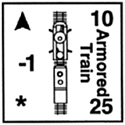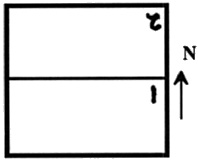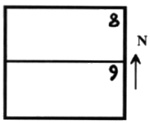 Editors Note: This is the first of a series
of articles on expanding your Landships! game
using the optional pieces included in the box. 7he
format will typically take the form of brief
introduction, some rules, and then some
scnenarios using the new pieces. By all means,
write to let us know if we're "on track" with this
sort of stuff. Special thanks to Bruce Bonneveir
and Eric Lyons for helping out.
Editors Note: This is the first of a series
of articles on expanding your Landships! game
using the optional pieces included in the box. 7he
format will typically take the form of brief
introduction, some rules, and then some
scnenarios using the new pieces. By all means,
write to let us know if we're "on track" with this
sort of stuff. Special thanks to Bruce Bonneveir
and Eric Lyons for helping out.
The lineage of the armored train goes back to 1862 and the American Civil War. Outside the gates of Richmond, Confederate forces mounted a single cannon with a gun shield on an open topped flat car, pushed by an engine. The weapon was effective in frightening McClellan, though its potential destructive power was low. Armored trains were largely ignored in the following three decades but once more came into their own during the Second Boer War (1899-1902).
The British used them to great effect in patrolling the vast open spaces of South Africa (despite Winston Churchill denigrating them in his memoirs - perhaps because he was captured in one!). By the time of the Great War, armored trains were firmly established in every Great Power's arsenal. Indeed, were it not for their fatal limitation of only being able to operate where rail lines were present, armored trains might well have become the "landships" of popular imagination. Naturally we couldn't resist including them in our game. Rules for the armored train counter are presented here for the first time.
General Rule: Armored trains are considered simply to be large Vehicles for most rules purposes. They have a facing indicator printed on the counter. The position of an armored train is simulated on the map through use of the armored train counter. Because armored trains varied wildly in equipment, armament and protection, a separate display is used to track the status of each armored train. Each armored train consists of an engine plus one to five rail cars, so photocopy the display on page 8 to string together the larger trains..
Movement: Armored trains move during the Vehicle Movement Phase. They may only move along roads that are designated as "tracks" in the scenario special rules. Armored trains may not change facing except to follow the natural course of the track (no spinning in place!) but do not pay any extra MPS cost to do so. Armored trains may go into reverse and travel along the track in exactly the same manner. Any armored train that reverses direction from one turn to the next may only move one half its printed Movement Allowance that turn. A train that loses its engine may not move at all. Trains may never leave the "tracks" and enter other terrain types. Trains never suffer Break Downs.
 Layout and Design: Using the
display, players will note each armored train
consists of an engine and a number of cars, each
with boxes printed on them. The display is kept
hidden by the owning player, until the train is
spotted by one of the opposing player's units. One
rail car on the display must be selected to be the
engine, and only one crew counter may be placed
on it, no Weapon Units or platoons may be
placed on the engine. Otherwise, each rail car has
three holding boxes printed on it.
Layout and Design: Using the
display, players will note each armored train
consists of an engine and a number of cars, each
with boxes printed on them. The display is kept
hidden by the owning player, until the train is
spotted by one of the opposing player's units. One
rail car on the display must be selected to be the
engine, and only one crew counter may be placed
on it, no Weapon Units or platoons may be
placed on the engine. Otherwise, each rail car has
three holding boxes printed on it.
A player may place up to one ART or AA or AT gun plus a crew, or up to three MG platoons, or one infantry platoon, or any combination thereof, per rail car. AT Rifles and Flamethrowers may be carried as well. Note that end cars and center cars on the display have different fields of fire. Field of fire restrictions must be observed at all times, including the MG/infantry platoons stacked on board. All Weapon Units are considered to be on 360 degree mounts when on the train, they may fire in any direction permitted by the field of fire arcs without the + l/ + 2 penalty for firing outside the covered arc. Note that AA Guns have full 360 degree fire arcs when firing at aircraft, regardless of the indicated fire arc restrictions.
Protection: Each armored train is given a protection rating in each scenario of + 1 to +3, reflecting the degree of protection afforded to SAFA, Barrage, and ATFA attacks. The defender may add the protection rating as a die roll modifier on the SACRT, BCRT or ATCRT, but does not receive any additonal benefits due to the terrain the train is in.
Combat: During the Offensive or Defensive Fire Phases, players may fire any on board Weapon Units or MG/infantry platoons the train possesses. All on board Weapon Unit and MG/infantry platoons possess a direct fin Weapons Range of 10 (if their normal WR is less than 10), due to the higher platforn they're on (optionally, WUs with a printed WR of 10 may fire up to 12 instead). Player may not conduct indirect fire Barrage Attack using on board ART guns, but may conduct AA attacks at any range up to their AA weapon's printed WR.
SAFA and Barrage Attacks vs. armored train are handled in the normal manner (combine all SAFA values into one total) except each crew and platoon undergoes a separate roll on the SACRT (using the train's protection rating a a modifier) to see if it is Hit. If Hit, it undergoes the normal check to see if it is Pinned or Eliminated. Crews and platoons may not fire if Pinned. The train may not move if the engine Crew is Pinned. Units forced to Retreat off a train are Eliminated instead.
AFTA Attacks against trains may be made a well. AFTAs are randomly targeted against one of the rail cars on the train, roll a 6 side die to determine which car is hit. AFTA against armored trains receive a -1 die to modifier due to the size of the rail cars while the protection rating of the train is treated as positive die roll modifier. If a Hit is scored all Weapons Units and Crews on that rail car are Eliminated (platoons are unharmed). If a Hit is scored on the engine, the crew is Eliminated and the train may no longer move.
Players may Barrage Attack rail lines in hope of cutting them. This is accomplished in the same manner as cutting Wire, and has the same chance of success. Trains may not enter a hex with a cut rail line.
Armored trains may not initiate Close Assault Combat but may be attacked by enemy units using Close Assault. The train and any infantry platoons all count towards the unit total. Weapons Units and Crews and MG platoons (no matter how many) do not count for Close Assault Combat purposes.
Air units may attempt to bomb trains, treat them as tanks (an "E" result is required to eliminate them).
Miscellaneous: Trains may discharge their passenger platoons (but not their on-board Weapons Units), but may never pick them (or any other units) up during the course of a scenario unless specially allowed to do so by the scenario rules.
Scenario 19.23: "Seizing the Dead Man"
On March 6th, 1916, the Germans renewed their efforts to seize the hill known as "Mort Homme" (Dead Man), the key to unflanking the French left at Verdun. The attack itself was planned as a flank attack. The new German VI Reserve Corps would launch a diversionary frontal assault to pin down the defenders on Mort Homme while the German 77th Brigade crossed the Meuse River to take them in the flank. Defending the Meuse was a poorly led French division, the 67th.
After an incredibly heavy barrage, German troops under General von Zwehl jumped off in a snowstorm. Little did the French know the wily von Zwehl had also smuggled a small armored train close in to the front as "insurance" for his boys in the assault.
 Map Set Up: Maps 1
and 2
Map Set Up: Maps 1
and 2
Game Length: 12
turns
Germans (1st Player): Set up second
Any 25 infantry platoons (no more than half may be 4-6-5s) and any 6 MG platoons (no more than half may be 4-9-5s) plus two FOs set up anywhere east of the river line. A total of 15 off board artillery modules are available throughout the game (no smoke or gas).
German Reinforcements: On turn 2, an armored train becomes available and may enter along any road hex along the east edge of the map. The train possesses two 77mm ART guns plus crews, three 4-9-5 MG platoons and a engine crew and so requires a minimum of 4 cars. It's protection rating is +2.
French (2nd Player): Set up first
Any 16 infantry platoons and any 3 MG platoons set up west of, but within 4 hexes of, the river. No units selected may have Fire Values greater than 3 or MR greater than 4.
French Reinforcements:
On Turn 5, eight infantry platoons (of any value) and two MG platoons (of any value) plus two FOs may appear along the west edge of the map, or along the south edge, west of the river. Ten total off board artillery modules become available for the rest of the game.
Special Rules: All road hexes east of the river are considered to be rail hexes instead. The armored train may exit the east edge of the map and reappear at a different road hex the next turn. All bridges are destroyed at the start of the game. It's considered to be snowing the first 10 game turns so reduce all Spotting Ranges by 2. French artillery had particularly bad fuses during this engagement, increase all French BCRT die rolls by +1.
The trench lines running along the west edge of the map do not exist, instead the first row is considered a hill slope hex so the area to the west of the trench is all considered high ground (use the higher elevation increased visibility optional rule). The strongpoints printed on the map do exist.
Victory Conditions: The German player wins by exiting 10 platoons off the west edge of the map, otherwise it's a French win.
Aftermath: The opening barrage stunned the defenders, severing all communications with the rear. Crossing the Meuse at Brabant and Champneuville, the Germans quickly pocketed the defenders, helped immeasurably by direct fire support from the armored train. French artillery observers soon spotted the tell tale smoke from the train and zeroed in, forcing it to withdraw. But many French shells fail to go off in the soft snowy ground. Much territory was taken that day along with 3,000 French prisoners, but not the vital Mort Homme, due to the diversionary frontal attack degenerating into an utter fiasco.
Scenario 19.24: "The Red Train"
Towards the end of the war, the French 3rd Company, 303rd Tank Regiment, comprised of FT-17s was secretly transferred to Rumania in hopes of getting the Rumanians to re-enter the war. The war ended before Rumania could decide and by December 1918 the tank company found itself in southern Russia, fighting against the new Bolshevik menace. The unit was plagued by maintenance problems and poor morale (who wants to get killed after the "War to End All Wars" is over?).
 On March 21st, 1919, the company attacked, along with White Russian Army units,
against the Bolshevik's 1st Zadnieprovskiy Division. Little did the tankers suspect the Reds
were backed up by an armored train.
On March 21st, 1919, the company attacked, along with White Russian Army units,
against the Bolshevik's 1st Zadnieprovskiy Division. Little did the tankers suspect the Reds
were backed up by an armored train.
Map Set Up: Use Maps 6 and 8 Game
Length: 12 turns
Allies (1st Player): Use the Allied pieces: Set up second
No units at start.
Allied Reinforcements: On Turn 1, 18 infantry platoons of any type, plus 6 cavalry platoons of any type, along with one FO enter anywhere along the south edge of the map. Fifteen FT-17 tanks (all tanks are MG armed except for three which have 37mm guns - use FT-17s with the Char 2C's backprinted on them to designate which are which) also may enter anywhere along the south edge of the map but must be divided into three groups of five.
Each group cannot enter closer than 5 hexes from each other (no restriction on tanks within the group however). Three artillery modules are available throughout the first five game turns (no smoke or gas may be used). One Sopwith Salamander (CS) is available at start.
On Turn 5, another 3 artillery modules become available for the rest of the game (no smoke or gas attacks).
Bolsheviks (2nd Player): Use the Central Powers pieces. Set up first:
15 infantry platoons (no more than 5 may have a FV of 4 or more) plus 3 MG platoons (of any type) set up in the specially designated trench hexes on Map 6. No more than one unit may start per trench hex. Ten Wire counters and one FO may be placed anywhere on the Map 6.
Three artillery modules are available throughout the game (no smoke or gas may be used). An armored train may be hidden (write down the hex number) in any town hex of Al Rami on Map 8. Keep it off the map until spotted. The train possesses one 77mm ART and 37mm AT gun plus crews, three 4-9-5 MG platoons, plus two infantry platoons (of any type) plus an engine crew (a minimmun of 5 cars is required to hold all this). Protection rating is +3.
Bolshevik Reinforcements: On Turn 3, five cavalry and one cavalry MG platoon enter from the east side of Map 6, north of the trench line.
Special Rules: The road hexes on Map 6 stretching from hex 4025 to 7025 are considered to be trench hexes instead. In addition, the town of Al Rami on Map 8 does not possess any trench or minefield hexes. Instead treat the trench hexes of Al Rami as additional town hexes. The strongpoints do exist for game purposes. Treat all terrain effects modifiers cumulatively (for example hex 5025 on Map 6 is now a trench/woods hex).
The road on Map 8, stretching from hex 4617 to 7068 is considered to be a rail line. The Red player may also secretly designate either the easternmost or westernmost trench line running north to south through Al Rami as a rail spur, allowing the train to operate along it. For facing purposes, treat the trenches making up this rail spur as facing it such a way to directly connect the adject hexes.
EXAMPLE: If the train were in hex 5910, it could only face in directions 114 or 215 (as indicated by the the artillery scatter diagram).
Red infantry and MG platoons only are subject to tank fright in this scenario (see the special rules in Landships! Scenario 17.5.
Due to poor morale, all tanks crews are subject to the German Tank Crew rules (see Module 15.0 in Landships). In addition, the FT- 17 breakdown modifier is decreased to 0 in this scenario.
Victory Conditions: Either player wins by solely occupying the town of Al Rami on Map 8 with his units by game end. Otherwise, compare the number of vehicles and platoons from each side (train and its passengers count as 1 unit). If either side has two or more than the other, it wins. Any other result is a draw.
Aftermath: This action was probably the Renault FT-17's first encounter with an enemy armored vehicle and the Renault's came off second best. The tank attack, supported by the ragged White Russian Army units, started well enough. The defenders lacked any sort of AT weapons and naturally broke.
Once the tanks encountered the train, the tables turned and the Bolsheviks were left in control of the battlefield, with five FT-17 hulks littering the countryside. The Reds managed to salvage four of these and created their own tank platoon, which along with two sections of armored cars became the Red Army's "Special Purpose Armored Troop".
Next article: We'll look at some more realistic trench and terrain rules that really give the defense its proper edge.
Back to Art of War Issue #21 Table of Contents
Back to Art of War List of Issues
Back to MagWeb Master Magazine List
© Copyright 1995 by Clash of Arms Games.
This article appears in MagWeb (Magazine Web) on the Internet World Wide Web.
Other military history articles and gaming articles are available at http://www.magweb.com